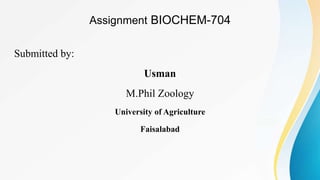
Biochemistry of interferons and interleukins
- 1. Assignment BIOCHEM-704 Submitted by: Usman M.Phil Zoology University of Agriculture Faisalabad
- 2. Topic Biochemistry of Interferons and Interleukins
- 3. Introduction Cytokines are a cell-signaling group of low molecular weight extracellular glycoproteins synthesized by different immune cells, mainly, by T cells, neutrophils and macrophages, which are responsible to promote and regulate immune response Different types of cytokines had been discovered, including ● Chemokines, ● Interferons (IFN) ● Interleukins (IL) ● lymphokines and ● Tumor necrosis factor.
- 4. Interferons ● IFNs belong to the large class of proteins known as cytokines, molecules used for communication between cells to trigger the protective defenses of the immune system that help eradicate pathogens. ● Interferons are named for their ability to "interfere" with viral replication by protecting cells from virus infections. ● IFNs also have various other functions: they activate immune cells, such as natural killer cells and macrophages; they increase host defenses by up-regulating antigen presentation by virtue of increasing the expression of major histocompatibility complex (MHC) antigens.
- 5. Definition of Interferon ● Interferon is operationally defined as a cellular protein produced in response to, and acting to prevent replication of, an infecting virus within the invaded cell. Interferon can be produced in cells both in tissue culture and in the intact animal. ● In other words, Interferons are a group of signaling proteins made and released by host cells in response to the presence of several viruses ● Interferon is a family of glycoproteins of which can be stimulated by viral infections by intercellular paracites, protozoa and by bacteria that exerts antiviral activity and have immunoregulatory fucnctions. They also inhibit the growth of nonviral intracellular paracites
- 6. Classification of Interferon There are mainly three classes of interferons ● Alpha ● Beta ● Gamma But two other classes are also discovered recently ● Omega Interferons ● Tau Interferon
- 8. Types of Interferons Based on type of receptors human interferons have been classified into three major types 1. Type 1 interferon 2. Type 2 interferon 3. Type 3 interferon
- 9. Interferon Type 1 All type of the interferon 1 binds to specific cell surface receptor complex and known as the IFN-α receptor that consists of IFNAR1 AND IFNAR2 chains. The type 1 interferon present in humans are α, β, ε, ω. ● Interferon α, ω are produced predominantly from leukocytes ● Interferon β can be produced by most cell types i.e fibroblasts
- 10. Type 2 Interferon ● It is composed of single subtype ● It can binds to its own unique receptors ● These are produced by T lymphocytes and natural killer cells ● And they are produced in response to the immune and inflammatory stimuli ● Binds to IFNGR that consists of IFNGR 1 and IFNGR 2 chains. In humans this is IFN-γ
- 11. Type 3 Interferon ● Signal through a receptor complex consisting of IL1 and IFNLR1. Acceptance of this classification is less universal than that type 1 and 2. ● Although discovered more recently than type I and type II IFNs recent information demonstrates the importance of Type III IFNs in some types of virus or fungal infections. ● present antiviral activity. ● type II IFN are essential in the immediate cellular response to viral infections
- 12. Introduction to Interleukins The first interleukins were identified in the 1970s Initially investigators believed that interleukins were made chiefly by leukocytes (white blood cells) to act primarily on other leukocytes, and for this reason they named them interleukins, meaning “between leukocytes.” Interleukins (ILs) are a group of secreted proteins with diverse structures and functions.
- 14. Definition of Interleukin Interleukin any of a group of naturally occurring proteins that mediate communication between cells. Interleukins regulate cell growth, differentiation, and motility. They are particularly important in stimulating immune responses, such as inflammation. In other words: A glycoprotein lymphocyte product that stimulates the growth of T cells and is used experimentally in cancer therapy; T cell growth factor.
- 15. Types of Interleukins Fifteen different types of interleukins are known, and they are designated numerically, IL-1 through IL-15 There have been identified 40 interleukins so far and some of them are further divided into subtypes (e.g. IL-1α, IL-1β). These ILs are grouped in families based on sequence homology and receptor chain similarities or functional properties. Two major families of interleukins are ● Interleukin-1 family ● Interleukin-2 family
- 16. Interleukin 1 family ● Interleukin-1 family is composed by 11 cytokines: 7 ligands with agonist activity (IL-1α, IL-1β, IL-18, IL-33, IL-36α, IL-36β and IL-36γ), 3 receptor antagonists. ● The interleukin-1 family started with only two components: IL-1α, IL-1β ● Both IL-1α and IL-1β have precursor forms ● The precursor of IL-1α is present in the epithelial layers of the gastrointestinal tract, lung, liver, kidney, endothelial cells and astrocytes. ● the precursor of IL-1β is not active and does not bind to the receptor ● new IL with similar behavior and/or structure were discovered and added to the family over the year
- 17. Interleukin 2 family The IL-2 cytokine family, also known as the common γ-chain family, is composed by ILs 2, 4, 7, 9, 15 and 21 All these ILs bind to the common γc receptor, also called CD132 IL-2 is the first member of the common γ-chain family, previously known as T cell growth Factor IL-4 is produced by Th2 cells, basophils, eosinophils and mastocytes. IL-9 is mainly produced by Th2 cells IL-7 is a homeostatic cytokine. It can be found essentially in T cells,
